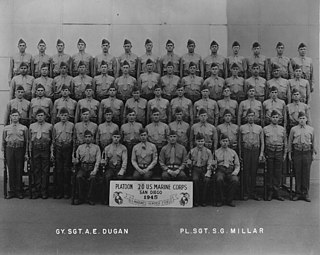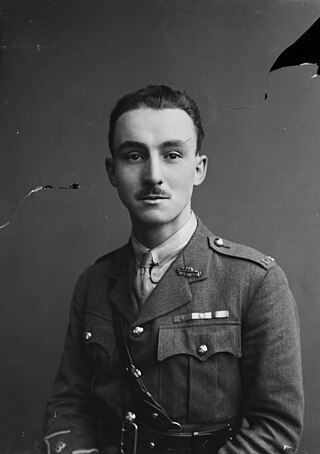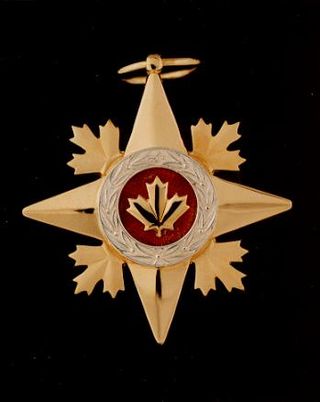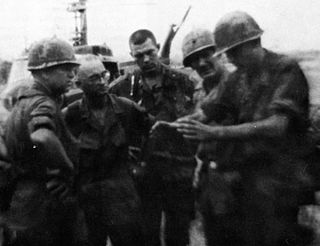
A platoon is a military unit typically composed of two to four squads, sections, or patrols. Platoon organization varies depending on the country and the branch, but a platoon can be composed of 20–50 troops, although specific platoons may range from 10 to 100 people. A platoon is typically the smallest military unit led by a commissioned officer. The platoon leader is usually a junior officer—a second or first lieutenant or an equivalent rank. The officer is usually assisted by a platoon sergeant.

A section is a military sub-subunit. It usually consists of between 6 and 20 personnel. NATO and U.S. doctrine define a section as an organization "larger than a squad, but smaller than a platoon." As such, two or more sections usually make up an army platoon or an air force flight.

William Henry Kibby, was a British-born Australian recipient of the Victoria Cross, the highest award for gallantry in the face of the enemy that could be awarded to a member of the Australian armed forces at the time. Kibby emigrated to South Australia with his parents in early 1914 and worked as an interior decorator and served in the part-time Militia prior to World War II. In 1940, he enlisted in the all-volunteer Second Australian Imperial Force and joined the 2/48th Infantry Battalion. His unit was sent to the Middle East, but soon after arriving, Kibby broke his leg and spent the next year recovering and undergoing further training while his battalion took part in the North African campaign. He rejoined his unit when it was serving on garrison duties in northern Syria after its involvement in the siege of Tobruk, but in June 1942 it was sent to Egypt and recommitted to the North Africa campaign. Kibby was with the battalion during the First Battle of El Alamein in July.

Brigadier Milton Fowler Gregg, was a Canadian military officer and a First World War recipient of the Victoria Cross, the highest award for gallantry in the face of the enemy that can be awarded to British and Commonwealth forces. In later life, he was a Member of the Canadian Parliament, cabinet minister, academic, soldier and diplomat.
The Star of the Commander of Valour is a medal awarded by the Malaysian government. The award was established on 29 July 1960, and it was formally gazetted by an act of parliament on 11 August 1960. It is Malaysia's second highest gallantry award, coming in second only to the Grand Knight of Valour.

The Star of Military Valour is a military decoration that is, within the Canadian system of honours, the second highest award for military valour, and one of three honours for military valour awarded by the Canadian monarch, generally through his or her viceroy-in-Council. Created in 1993, the medal is presented to both living and deceased members of the Canadian Forces deemed to have demonstrated "distinguished and valiant service in the presence of the enemy," and grants recipients the ability to use the post-nominal letters SMV.

The 2nd Ranger Battalion, currently based at Joint Base Lewis–McChord south of Seattle, Washington, United States, is the second of three ranger battalions belonging to the United States Army's 75th Ranger Regiment.
Canada's role in the Afghanistan War began in late 2001. Canada sent its first element of soldiers secretly in October 2001 from Joint Task Force 2, and the first contingents of regular Canadian Armed Forces (CAF) troops arrived in Afghanistan in January–February 2002. The operations were aimed at identifying and neutralizing Al-Qaeda members in that country and toppling the Taliban regime which was supporting international terrorism. Canada's role in the Afghan conflict grew in 2006 when Canadian troops relieved US forces in Kandahar province, taking command of the multinational brigade in the region during a major Taliban offensive.

The Battle of Ong Thanh was fought at the stream of that name on the morning of 17 October 1967, in Chơn Thành District, at the time part of Bình Dương Province, South Vietnam, today in Bình Phước Province.

Operation Medusa was a Canadian-led offensive during the second Battle of Panjwaii of the War in Afghanistan. The operation was fought primarily by the 1st Battalion, The Royal Canadian Regiment Battle Group and other elements of the International Security Assistance Force, including A Co, 2-4 Infantry BN, 4th BDE, 10th Mtn Division, supported by the Afghan National Army and a team from the United States Army's 1st Battalion, 3rd Special Forces Group (Airborne) augmented by C Company, 2nd Battalion, 87th Infantry Regiment of the 10th Mountain Division. Its goal was to establish government control over an area of Kandahar Province centered in the district of Panjwayi some 30 kilometres (19 mi) west of Kandahar city. A tactical victory, it resulted in the deaths of 12 Canadian soldiers; five during the major combat operations, five in bombings, and two in a mortar/RPG attack during the reconstruction phase of the operation. Fourteen British military personnel were also killed when their plane crashed. Despite suffering a brutal battlefield defeat, the Taliban retained their presence in Kandahar province and did not lose their will to fight, leading to the subsequent Operation Falcon Summit. Nonetheless, Operation Medusa was at the time the most significant land battle ever undertaken by NATO.

The Battle of Panjwaii was fought in mid-2006 with primarily Canadian and Afghan soldiers, supported by small elements of Dutch, American, and British forces against the Taliban. There were two separate times in which the forces were involved in heavy fighting in the region. The first phase was fought in July 2006, and the second encounter lasted from September to October 2006.
Master Corporal Collin Ryan Fitzgerald, MMV is a Canadian soldier who was among the first recipients of the Medal of Military Valour, a Canadian military decoration, in recognition of actions under enemy fire in Afghanistan. He belonged to Princess Patricia's Canadian Light Infantry.

Bryan James Budd, was a British Army soldier and a Northern Irish recipient of the Victoria Cross, the highest award for gallantry in the face of the enemy that can be awarded to British and Commonwealth forces.

The Battle of Takur Ghar was a short but intense military engagement between United States special operations forces and al-Qaeda insurgents fought in March 2002, atop Takur Ghar mountain in Afghanistan. For the U.S. side, the battle proved the deadliest entanglement of Operation Anaconda, an effort early in the War in Afghanistan to rout al-Qaeda forces from the Shahi-Kot Valley and Arma Mountains. The battle saw three helicopter landings by the U.S. on the mountain top, each met with direct assault from al-Qaeda forces. Although Takur Ghar was eventually taken, seven U.S. service members were killed and 12 others were wounded. The battle is also known as the Battle of Roberts Ridge, after the first casualty of the battle, Navy SEAL Neil C. Roberts.

The Battle of Shewan was a military engagement between Coalition forces and Taliban insurgents that took place on August 8, 2008, near the village of Shewan in the Bala Buluk district, Farah Province, Afghanistan.

The Battle of Kamdesh took place during the war in Afghanistan. It occurred on October 3, 2009, when a force of 300 Taliban assaulted the American Combat Outpost ("COP") Keating near the town of Kamdesh in Nuristan Province in eastern Afghanistan. The attack was the bloodiest battle for US forces since the Battle of Wanat in July 2008, which occurred 20 miles (32 km) away from Kamdesh. The attack on COP Keating resulted in 8 Americans killed and 27 wounded while the Taliban suffered 150–200 killed.

The Battle of Ganjgal took place during the War in Afghanistan between American and Afghan forces and the Taliban in Kunar Province, Afghanistan on September 8, 2009. Complaints that the coalition casualties were avoidable and caused by a failure of the chain of command to provide fire support for the team triggered an official investigation and a series of reprimands to several US military officers. Army Captain William D. Swenson and Marine Corporal Dakota Meyer received the Medal of Honor for their actions during the battle. Meyer is the first living Marine to receive the Medal of Honor since the Vietnam War, and Swenson is the fifth living soldier and second officer to receive the Medal of Honor since the Vietnam War. Two other Marines at the battle, Staff Sgt. Juan Rodriguez-Chavez and Capt. Ademola Fabayo, received the Navy Cross.

Lieutenant-General Omer Lavoie, CMM, MSC, CD was a senior officer in the Canadian Army and the Canadian Armed Forces. He was the commander of the 4th Canadian Division until the summer of 2014. He was promoted to major general in January 2016, and appointed commander of 1st Canadian Division. He served as battle group commander of the 1 RCR Battle Group, Task Force 3-06, from July 2006 to February 2007 in Kandahar, Afghanistan. In 2021, he served in the Canadian Army.

The 8th Battalion (Parachute), Royal Ranger Regiment (Malay: Batalion ke-8 Rejimen Renjer Diraja (Para)), better known as the 8 RRD or 8 RRD (Para) – abbreviation from its local name, is a battalion-sized airborne infantry from the Royal Ranger Regiment of the Malaysian Army. On 10 October 1994 the 8 RRD became part of the 10th Parachute Brigade. The 8 RRD is the first infantry unit in the Malaysian Army transformed from a conventional to an airborne unit.
Jess Randall Larochelle SMV was a Canadian war hero who was awarded the Star of Military Valour for bravery in the War in Afghanistan in 2006. A campaign was launched in 2021 to lobby for an upgrade of his award to the Canadian Victoria Cross and as of 2024 remains ongoing.















